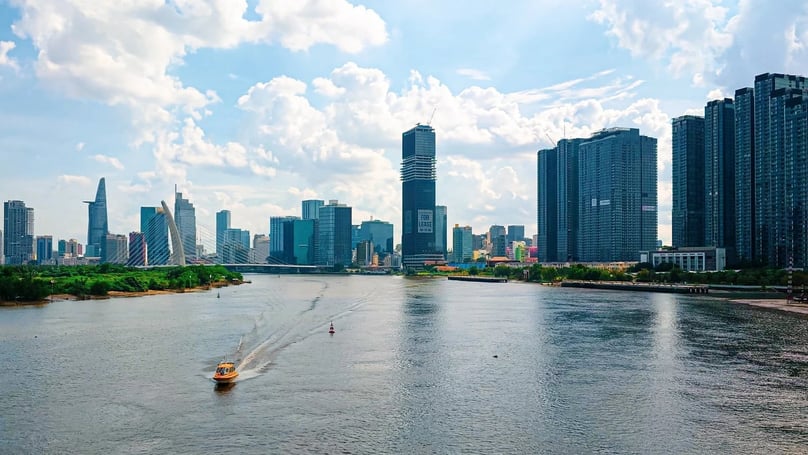By
Vu Pham, Chau Anh
Mon, April 14, 2025 | 11:43 am GMT+7
The average apartment price reached VND70.2 million ($2,721) per square meter in Hanoi in Q1, up 77.6% compared to the same period in 2019; VND71.8 million in Ho Chi Minh City, up 35%; and VND62 million in Da Nang city, a rise of 58.6%.

A view of Ho Chi Minh City, the southern economic hub of Vietnam. Photo by The Investor/Vu Pham
A report by the Vietnam Association of Real Estate Brokers (VARS) showed that the total market supply in Q1 amounted to 27,000 units, up 33% year-on-year.
Of this, 14,500 were newly launched, about half the volume of the previous quarter but three times higher than in Q1/2024. The remainder consists of unsold inventory still being marketed.
Pham Thi Mien, deputy director of the Vietnam Real Estate Market Research and Evaluation Institute, said residential projects launched in Q1 were well absorbed, driven by sustained demand.
“Additionally, investor sentiment has improved, with expectations of price increases in the medium to long term, supported by economic growth and the development of transportation infrastructure,” she noted.
At the same time, signals of monetary easing from the State Bank of Vietnam, coupled with the government’s directive to maintain low interest rates, have helped fuel property demand.
This trend is not only seen among homebuyers but also among individual investors, as real estate remains a popular investment channel with strong potential for returns and long-term asset preservation.
Vacant villas see price gains
In Q1, the overall market absorption rate was 45%, equivalent to 12,273 transactions, half of the previous quarter but double compared to the same period last year. The absorption rate rose 15 percentage points year-on-year, though it slipped 20 percentage points from 2024.
The absorption rate for newly launched projects reached approximately 60%, particularly in provinces and cities with clear information on urban planning, infrastructure, and new projects, such as the capital city of Hanoi, Ho Chi Minh City, and Ha Nam, Hai Phong, Thai Nguyen, and Bac Giang in the north, and Da Nang and Thanh Hoa in the central region. These areas are also attracting investment flows from Hanoi-based investors.
Mien noted that apartments continued to dominate the market, accounting for 72% of transactions. However, the absorption slowed as supply remained primarily driven by projects in the Hanoi area, while demand in the capital city is currently adjusting after a period of rapid growth.
The absorption rate for newly launched low-rise projects was around 52%. Some high-priced projects continue to attract demand from affluent homebuyers as well as investors seeking long-term asset preservation, driven by announcements regarding new infrastructure developments, which benefit nearby projects.
In the secondary market, Mien said, transactions and prices for low-rise products and land plots also saw significant increases, particularly in Hanoi’s suburbs, buoyed by a series of newly launched projects with high prices. In fact, many villas and townhouses that had been vacant for years are now being sold at prices up to 30% higher, and in some cases, even double the levels in 2023
However, in reality, the increase in transactions volumes and prices was limited to land plots with reasonable investment value, typically priced below VND2 billion ($77,556), with secure legal titles, located in areas where infrastructure is being developed, or in low-rise products within large urban projects that have already seen infrastructure investment and offer a full range of amenities.
Notably, the real estate market experienced a shift in the quarter, with a ‘southward migration’ of both sales agents and investors, as well as homebuyers, looking to capitalize on the investment wave driven by a range of large-scale projects in the southern region that have already launched or are expected to be introduced in the near future
Affordable apartments completely absent
According to Mien, despite the positive outcomes, the real estate market in Q1 still faces several unresolved issues, posing potential risks to the market’s sustainable development. The housing supply structure remains severely unbalanced, with new project offerings primarily catering to high-income buyers and investors seeking products with long-term value appreciation.
The apartment segment continues to dominate, accounting for over 69% of newly launched housing supply in the quarter. However, luxury and high-end apartments still hold a significant share, with the number of new luxury projects on the rise, while affordable commercial apartments have completely disappeared from the market. The share of affordable apartments improved slightly with nearly 2,000 units, but this remains a small fraction of the demand.
Price levels are increasingly on the rise, driven by cost pressures, especially land-related expenses, amidst the growing scarcity of available land, leading developers to favor high-end projects to secure profit targets.
Mien said from 2019 to 2025, Danang’s apartment price growth has been remarkable, with an increase approximately 1.6 times higher than in HCMC. This is primarily due to the introduction of many new projects being offered at significantly higher prices, helping to establish a new price level for the market.
The expert emphasized that high primary sales prices are partly why some young people are now forced to choose between renting and purchasing a home.
In addition, in Q1, the market was impacted by the ongoing mergers of cities and provinces. Several areas, such as Ninh Binh, Ha Nam, Hai Phong, Bac Giang, Hai Duong, and the outskirts of Hanoi, all in the north, saw price increases of 5-30%.
However, transactions only increased in areas expected to become merger centers, where infrastructure, economy, and social development are strong, and where property prices have not yet reached excessive levels.
From: The Investor
Real Estate News










